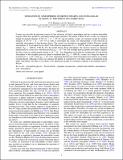Files in this item
Ionization in atmospheres of brown dwarfs and extrasolar planets. IV. The effect of cosmic rays
Item metadata
| dc.contributor.author | Rimmer, Paul | |
| dc.contributor.author | Helling, Christiane | |
| dc.date.accessioned | 2014-05-09T10:31:00Z | |
| dc.date.available | 2014-05-09T10:31:00Z | |
| dc.date.issued | 2013-08-21 | |
| dc.identifier | 74455262 | |
| dc.identifier | 97b2fa9c-6510-4e8d-9a25-65983d2dcd0a | |
| dc.identifier | 000323888900017 | |
| dc.identifier | 84883642645 | |
| dc.identifier.citation | Rimmer , P & Helling , C 2013 , ' Ionization in atmospheres of brown dwarfs and extrasolar planets. IV. The effect of cosmic rays ' , Astrophysical Journal , vol. 774 , no. 2 , 108 . https://doi.org/10.1088/0004-637X/774/2/108 | en |
| dc.identifier.issn | 0004-637X | |
| dc.identifier.uri | https://hdl.handle.net/10023/4747 | |
| dc.description.abstract | Cosmic rays provide an important source for free electrons in Earth's atmosphere and also in dense interstellar regions where they produce a prevailing background ionization. We utilize a Monte Carlo cosmic ray transport model for particle energies of 10(6) eV <E <10(9) eV, and an analytic cosmic ray transport model for particle energies of 10(9) eV <E <10(12) eV in order to investigate the cosmic ray enhancement of free electrons in substellar atmospheres of free-floating objects. The cosmic ray calculations are applied to Drift-Phoenix model atmospheres of an example brown dwarf with effective temperature T-eff = 1500 K, and two example giant gas planets (T-eff = 1000 K, 1500 K). For the model brown dwarf atmosphere, the electron fraction is enhanced significantly by cosmic rays when the pressure p(gas) <10(-2) bar. Our example giant gas planet atmosphere suggests that the cosmic ray enhancement extends to 10(-4)-10(-2) bar, depending on the effective temperature. For the model atmosphere of the example giant gas planet considered here (T-eff = 1000 K), cosmic rays bring the degree of ionization to f(e) greater than or similar to 10(-8) when p(gas) <10(-8) bar, suggesting that this part of the atmosphere may behave as a weakly ionized plasma. Although cosmic rays enhance the degree of ionization by over three orders of magnitude in the upper atmosphere, the effect is not likely to be significant enough for sustained coupling of the magnetic field to the gas. | |
| dc.format.extent | 10 | |
| dc.format.extent | 586112 | |
| dc.language.iso | eng | |
| dc.relation.ispartof | Astrophysical Journal | en |
| dc.subject | Astroparticle physics | en |
| dc.subject | Brown dwarfs | en |
| dc.subject | Magnetic reconnection | en |
| dc.subject | Planets and satellites: atmospheres | en |
| dc.subject | Stars: atmospheres | en |
| dc.subject | Low-mass stars | en |
| dc.subject | Diffuse interstellar clouds | en |
| dc.subject | Molecular clouds | en |
| dc.subject | Energetic particles | en |
| dc.subject | Escaping atmosphere | en |
| dc.subject | HD 209458B | en |
| dc.subject | X-ray | en |
| dc.subject | Model | en |
| dc.subject | Propogation | en |
| dc.subject | Ionosphere | en |
| dc.subject | QC Physics | en |
| dc.subject.lcc | QC | en |
| dc.title | Ionization in atmospheres of brown dwarfs and extrasolar planets. IV. The effect of cosmic rays | en |
| dc.type | Journal article | en |
| dc.contributor.sponsor | Science & Technology Facilities Council | en |
| dc.contributor.sponsor | Science & Technology Facilities Council | en |
| dc.contributor.institution | University of St Andrews. School of Physics and Astronomy | en |
| dc.identifier.doi | 10.1088/0004-637X/774/2/108 | |
| dc.description.status | Peer reviewed | en |
| dc.identifier.grantnumber | ST/J001651/1 | en |
| dc.identifier.grantnumber | ST/K001515/1 | en |
This item appears in the following Collection(s)
Items in the St Andrews Research Repository are protected by copyright, with all rights reserved, unless otherwise indicated.

